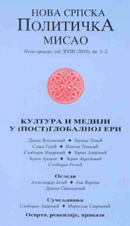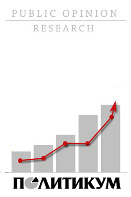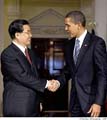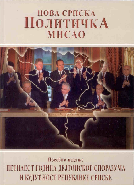| NSPM in English | |||
Collapse of the G-2 Myth |
 |
 |
 |
| среда, 03. март 2010. | |
|
(Strategic Culture Fondation, 2.3.2010)
Notably, the round of tensions came as a surprise – just recently US analysts used to churn out totally different predictions concerning the relations with China. US economist and the director of Peterson Institute for International Economics Fred Bergsten coined the term G-2 as the new global economy formula in his The United States and the World Economy (2005). In the early 2009, the concept was upheld by such US foreign politics gurus as former Secretary of State H. Kissinger and former White House National Security Adviser Z. Brzezinski. Their idea was that China should shoulder the burden of global hegemony jointly with the US, which implied that Obama's Administration would be steering a course generally benign to the country. Part I Visiting Beijing in November, 2009 US President B. Obama suggested establishing the G-2, but the offer was accompanied by rather imperious recommendations that China revalue the Yuan and join the regime of sanctions imposed on Iran. China declined on the grounds that its statehood was not yet sufficiently mature and needed serious modernizations and that, in foreign politics, Beijing's creed would be to maintain independence and to stay away from whatever alliances. By the time of Obama's visit, China had enough time to get familiarized in detail with the G-2 concept, and the official rejection of the offer to become a minor partner of the US was a product of broad consensus reached beforehand. Obama's November, 2009 visit should be regarded as the starting point of the chill between China and the US. The Iranian dimension deserves special attention in the context. China is the only remaining obstacle in the way of the crusade against Iran, and it depends on Beijing's position whether the resolution of the “Iranian problem” will follow the US blueprint. It is highly unlikely, though, that under any combination of circumstances China would refrain from vetoing in the UN Security Council the US proposal to impose sanctions on Iran. The explanation behind the stance is that Iran is China's major commercial and strategic partner. Over 15% of China's oil import (a total of some 450,000 bpd) are supplied by Iran, with only two countries - Angola and the Saudi Arabia - supplying greater amounts. China took two important new steps to boost its cooperation with Iran in the energy sphere in the late 2009. China's state-owned Sinopec signed a contract with Tehran to develop the first phase of the Yadavaran oil field, one of Iran's largest, and to invest $6.5 bn in the upgrade of Iran's refining capacities. Beijing reckoned it maded no sense to scrap the plans in the name of taking the role of a minor partner in the duet with the US. The revaluation of the Yuan is a recurrent theme since the beginning of the current decade. China agreed to a compromise over the issue in 2005 when it set a flexible rate for Yuan synchronized with a pool of currencies, and the Yuan actually added 21% by July, 2008. The process came to a halt on the eve of the global economic crisis. Currently the exchange rate is about 6.82 Yuan per US dollar compared to 8.2 Yuan in the early 2005. Industrialized Western countries absorbing the majority of China's exports are unhappy with the arrangement: US President B. Obama and several other Western leaders believe that the artificially underrated Yuan shields the Chinese market from Western imports while giving Chinese exporters an unfair advantage. Western analysts maintain that China should revalue the Yuan to cap its breakneck economic growth. Though the strengthening of Yuan would cause China's export and the corresponding revenues to shrink, it would carry the beneficial effect of impeding the inflow to the country of speculative investments which drive the inflation. Last February, Goldman Sachs analysts anticipated a 5% revaluation of Yuan to follow shortly, but Beijing remained unresponsive. Beijing found an alternative approach to curbing financial risks – according to the US Department of the Treasury, in December, 2009 China sold $32.2 bn worth of US bonds and thus reduced its stockpile of US bonds to $755 bn. As a result, currently - for the first time since August, 2008 - Japan, not China, is the world's largest holder of US bonds (with a total of $769 bn). The official version is that China dumped the US bonds in an effort to diversify its currency holdings. To avoid excessively injecting liquidity, China will not likely opt for quick cuts of investments in US bonds. They continue to play an important role in the Chinese currency reserves – the US securities account for some 70% of China's total which has topped $2.3 trillion. Still, China's getting rid of a fraction of its dollar assets had repercussions worldwide and may be indicative of the country's long-term strategy. A new problem in the Chinese-US relations emerged this winter as Google charged China with flooding the world with spyware. According to Google, cyber attacks against its corporate infrastructures had been launched from China. Namely, attempts were made to break the mailboxes registered on Google by Chinese dissenters. Google responded by lifting search request censorship via its engine, thus momentarily conquering a greater share of the Chinese market. Chinese citizens eagerly seized the opportunity to examine the alternative versions of the 1989 Tian'anmen Square tragedy, the situation around Tibet, Xinjiang, the Taiwan problem and other themes to which the official Beijing has a thin skin. Chinese officials, army, and academic circles deny involvement in the cyber attack, automatically switching the suspicion to Baidu, the main domestic company posing competition to Google. Analysis International says Baidu's market share was roughly twice that of Google in the second half of 2009 – 61.6% vs. 29.1%. While the disparity persists, the gap between the two companies is steadily growing narrower year by year. At the moment Google's withdrawal from the Chinese market and its compromise with the Chinese administration – that is, the reinstatement of censorship - seem equally possible. Considering that China is home to some 20% of the world's Internet surfers, it is clear that the US company would hate to lose grip on such a market. Responsibility for provoking yet another serious conflict rests with the US. Washington hurt China in the sphere to which the country's administration is no less sensitive than to the issue of freedom of speech – the US planned to go ahead with a $6.4 bn deal to supply arms to Taiwan. The arsenal Washington intended to sell to the island Beijing regards as its own province comprised 60 Black Hawk UH-60M copters, 114 Patriot PAC-3 interceptors, 12 Harpoon Block II anti-ship missile systems, 2 Osprey-class minehunters, and the modernized Po Sheng commands and control system designed specifically to meet the needs of the Taiwanese army. Beijing reacted promptly, and the response was harsh. A note of protest was handed over to the US ambassador to China. An official statement charged the US with intervening into China's domestic affairs and threatening its national security. The diplomatic protest was paralleled by a number of measures the US certainly had to be upset with. China canceled the program of military cooperation with the US and imposed sanctions on the US companies involved in the deal with Taiwan. The list of companies affected included Boeing, United Technologies, Raytheon, and Lockheed Martin. The first two of the above were active players on China's domestic market. The administration of Taiwanese President Ma Ying-jeou also faced a difficult situation. Last January China and Taiwan opened negotiations on a proposed economic cooperation framework agreement (ECFA), and chairman of the Kuomintang Ma Ying-jeou actually had to mobilize all of his political influence while pushing for it. Reaching the deal ranks high on Taiwan's list of economic priorities. The China-ASEAN agreement entered into force on January 1, 2010, and in case the ECFA fails to materialize, Taiwan will find itself disadvantaged in the stiff regional economic rivalry as its products will be unable to compete against those from the ASEAN countries. The regime of free trade with China for Indonesia, Vietnam, and other South East Asian countries dealt Taiwan's economy a heavy blow. While Beijing is Taipei's number one trade partner, Taipei is somewhere at the bottom of top 20 for Beijing. *** US President B. Obama's meeting with 14th Dalai Lama Tenzin Gyatso could be expected to be a peripheral event in the context of the overall escalation between China and the US. Moreover, Dalai Lama's visit took place during the normally not too eventful Chinese New Year vacations, but Beijing never stops monitoring Dalai Lama's tours, and the reaction followed without delay. Obama's explanation that he received his guest as a religious rather than political leader of Tibet was brushed off by China which perceived the meeting of the two Nobel Prize winners at the white House as a political gesture. It should be noted that, unlike G. Bush, B. Obama talked to Dalai Lama in the Map Room instead of the Oval Office and did not present him with the Congressional Gold Medal. It is widely held that Dalai Lama's visit to the US reflects Washington's attempt to sow geopolitical discord in South Asia and to ignite tensions between the region's two heavyweights India and China. China plans to diversify the routes via which it imports oil and gas from the Persian Gulf and Africa. The construction of a 1,100 km oil and gas pipeline to link Burma and China's Yunnan province began in September, 2010. The project will be phased in by 2012 and will reduce China's transit risks currently stemming from the need to navigate the Strait of Malacca which is plagued by piracy. The new transit avenue will traverse Sri Lanka, the country whose friendship with China is energized by considerable Chinese investments in its economy. In contrast to Burma and Sri Lanka, India is a country having strained relations with China due to border disputes and to Dalai Lama's public activity. India is clearly concerned over the march of Chinese companies across the neighboring countries. On top of that, New Delhi's relations with Colombo and Naypydaw are also far from ideal. Speaking of the relations between the US and China, the key question is what are the reasons that suddenly caused them to turn sour and forced both countries to tighten their foreign policies. As for the US though, it should be realized that the surprise at its tougher stance should be attributed solely to the contrast with the promise of softer politics that was carried by Obama's electoral campaign. The new US President did make attempts to sense new approaches over his first year in office: he denied approval to the arms deal with Taiwan and did not receive Dalai Lama during the Tibet leader's previous US tour. Moreover, H. Clinton even pledged to tame the criticism of Beijing over human rights. The reversion to Bush-style international politics must be linked to the pressure to which B. Obama is exposed in connection with an array of domestic issues, mainly the healthcare reform which was supposed to become the highlight of his political career. Besides, the US establishment mounts unyielding resistance to any changes that have a potential to affect the American primacy. As a result, the President has to demonstrate determination to uncompromisingly maintain the US global leadership, and Washington's international politics is growing increasingly hawkish. The motivation behind the evolution of Beijing's position is not so easy to track, and there coexist several more or less realistic explanations of the shift from the policy of “soft ascension” to Mao Zedong-style strategems. Conservative western commentators are convinced that China is showing its true face of a power denied the desired rights and seeking an overhaul of the global balance. Chinese analysts say the global financial crisis which they blame on the West explicated the advantages of China's economic development model and thus made the country's leadership more assertive. Yet another explanation is that the tougher course in foreign politics is a byproduct of the power transition which has already commenced in China in anticipation of the XVIII Congress of its Communist Party scheduled to convene in 2012. The point is that nationalist politics tentatively improves the standing of top candidates. An alternative point of view is that the army and the conservative circles in China prevailed over reformists and are demanding a more authoritarian politics. The conflict between the two countries claiming global leadership is underway, but certain intermediate conclusions can already be drawn. The US as the current uncontested leader employs a strategy based on force while China - the leader of the future – mainly relies on economic pressure. As of today, the US has lost more in the game: Boeing, United Technologies, and quite likely Google are facing the risk of expulsion from the lucrative Chinese market. Moreover, the dumping of the US bonds by China had the effect of undermining the trust in US bonds on a global scale. In contrast, China's damage seems to be confined to the image level. The cyber-war episode, the muscling of the US companies, and the support for Tehran provided Western commentators and media with pretexts for various allegations against China, and there is a probability that the media campaigns would eventually tell on China's ability to attract investments. On the whole, a full-blown row between China and the US is unlikely. Neither of them need it as both stand to lose a lot economically from such conflict. The economies of the two giants are interwoven and interdependent, the arrangement has proved stable over decades, and no alternative to it looms on the horizon. Still, it is hard to predict the duration of the current chill. One thing is certain: at least for the coming several years, the G-2 concept stands no chance. ______________________ Roman Tomberg is an expert of the Strategic Culture Foundation and a graduate student at the Energy Studies Center of the Moscow Institute for International Relations. http://en.fondsk.ru/article.php?id=2825 |
Од истог аутора
Остали чланци у рубрици
- Playing With Fire in Ukraine
- Kosovo as a res extra commercium and the alchemy of colonization
- The Balkans XX years after NATO aggression: the case of the Republic of Srpska – past, present and future
- Из архиве - Remarks Before the Foreign Affairs Committee of the European Parliament
- Dysfunction in the Balkans - Can the Post-Yugoslav Settlement Survive?
- Serbia’s latest would-be savior is a modernizer, a strongman - or both
- Why the Ukraine Crisis Is the West’s Fault
- The Ghosts of World War I Circle over Ukraine
- Nato's action plan in Ukraine is right out of Dr Strangelove
- Why Yanukovych Said No to Europe

.jpg)








 This winter has been a cold one for China-US relations. So many serious disagreements between the two countries have not surfaced simultaneously for decades: the US is exerting unprecedented pressure on China to revalue the Yuan, a cyber war erupted between Google and the Chinese administration, Washington intends to sell weapons worth $6.4 bn to Taiwan, China dumped US bonds worth $34.2 bn, both sides threaten to introduce punitive import tariffs, and US President B. Obama received 14thDalai Lama Tenzin Gyatso in the White House. In the past China and the US avoided taking harsh measures against each other serially, but evidently things have changed beyond recognition over the past several months.
This winter has been a cold one for China-US relations. So many serious disagreements between the two countries have not surfaced simultaneously for decades: the US is exerting unprecedented pressure on China to revalue the Yuan, a cyber war erupted between Google and the Chinese administration, Washington intends to sell weapons worth $6.4 bn to Taiwan, China dumped US bonds worth $34.2 bn, both sides threaten to introduce punitive import tariffs, and US President B. Obama received 14thDalai Lama Tenzin Gyatso in the White House. In the past China and the US avoided taking harsh measures against each other serially, but evidently things have changed beyond recognition over the past several months.









